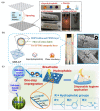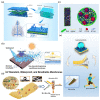Up to Date Review of Nature-Inspired Superhydrophobic Textiles: Fabrication and Applications
- PMID: 37959613
- PMCID: PMC10649416
- DOI: 10.3390/ma16217015
Up to Date Review of Nature-Inspired Superhydrophobic Textiles: Fabrication and Applications
Abstract
In recent years, with the rapid development of the economy and great progress in science and technology, people have become increasingly concerned about their quality of life and physical health. In order to pursue a higher life, various functional and biomimetic textiles have emerged one after another and have been sought after by people. There are many animal and plant surfaces with special wettability in nature, and their unique "micro-nano structures" and low surface energy have attracted extensive attention from researchers. Researchers have prepared various textiles with superhydrophobic features by mimicking these unique structures. This review introduces the typical organisms with superhydrophobicity in nature, using lotus, water strider, and cicada as examples, and describes their morphological features and excellent superhydrophobicity. The theoretical model, commonly used raw materials, and modification technology of superhydrophobic surfaces are analyzed. In addition, the application areas and the current study status of superhydrophobic surfaces for textiles are also summarized. Finally, the development prospects for superhydrophobic textiles based on bionic technology are discussed.
Keywords: biomimetic textiles; lotus leaf; superhydrophobic surface; theoretical modeling.
Conflict of interest statement
The authors declare no conflict of interest.
Figures










Similar articles
-
Advances in the Fabrication and Characterization of Superhydrophobic Surfaces Inspired by the Lotus Leaf.Biomimetics (Basel). 2022 Nov 10;7(4):196. doi: 10.3390/biomimetics7040196. Biomimetics (Basel). 2022. PMID: 36412724 Free PMC article. Review.
-
Biomimetic superhydrophobic surfaces by combining mussel-inspired adhesion with lotus-inspired coating.Nanotechnology. 2015 Aug 21;26(33):335602. doi: 10.1088/0957-4484/26/33/335602. Epub 2015 Jul 29. Nanotechnology. 2015. PMID: 26222622
-
Bioinspired super-antiwetting interfaces with special liquid-solid adhesion.Acc Chem Res. 2010 Mar 16;43(3):368-77. doi: 10.1021/ar900205g. Acc Chem Res. 2010. PMID: 19954162 Review.
-
Superhydrophobic surfaces: from natural to biomimetic to functional.J Colloid Interface Sci. 2011 Jan 15;353(2):335-55. doi: 10.1016/j.jcis.2010.08.047. Epub 2010 Aug 24. J Colloid Interface Sci. 2011. PMID: 20846662 Review.
-
Robust and Eco-Friendly Superhydrophobic Starch Nanohybrid Materials with Engineered Lotus Leaf Mimetic Multiscale Hierarchical Structures.ACS Appl Mater Interfaces. 2021 Aug 4;13(30):36558-36573. doi: 10.1021/acsami.1c09959. Epub 2021 Jul 21. ACS Appl Mater Interfaces. 2021. PMID: 34284587
Cited by
-
Superhydrophobic Non-Metallic Surfaces with Multiscale Nano/Micro-Structure: Fabrication and Application.Molecules. 2024 May 1;29(9):2098. doi: 10.3390/molecules29092098. Molecules. 2024. PMID: 38731589 Free PMC article. Review.
References
-
- Khan M.Z., Militky J., Petru M., Tomková B., Ali A., Tören E., Perveen S. Recent advances in superhydrophobic surfaces for practical applications: A review. Eur. Polym. J. 2022;178:111481. doi: 10.1016/j.eurpolymj.2022.111481. - DOI
-
- Manoharan K., Bhattacharya S. Superhydrophobic surfaces review: Functional application, fabrication techniques and limitations. J. Micromanuf. 2019;2:59–78. doi: 10.1177/2516598419836345. - DOI
Publication types
LinkOut - more resources
Full Text Sources

